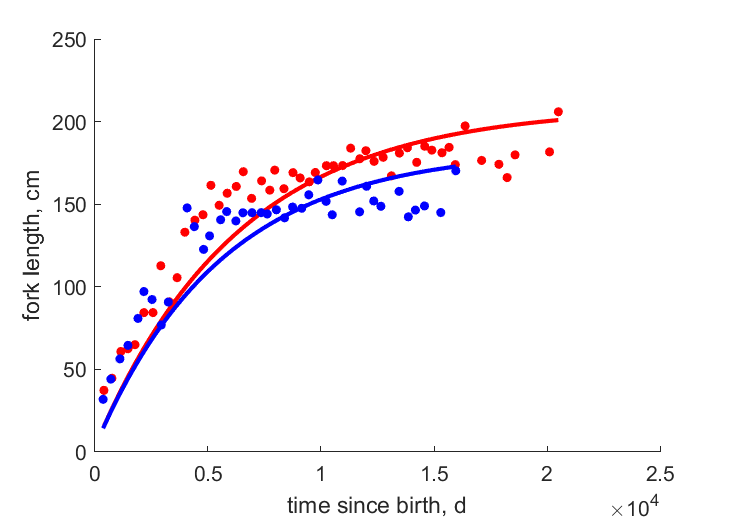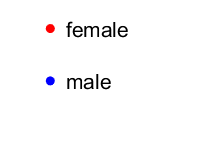Predictions & Data for this entry
| Model: ssj | climate: MA, MB | migrate: Ma | phylum: |
| COMPLETE = 2.0 | ecozone: MAW | food: bpCi, piCvf | class: |
| MRE = 0.226 | habitat: 0iMr, 0iMcp | gender: D | order: |
| SMSE = 0.128 | embryo: Fp, Mp | reprod: O | family: |
Zero-variate data
| Data | Observed | Predicted | (RE) | Unit | Description | Reference |
|---|---|---|---|---|---|---|
| ab | 2.5 | 3.629 | (0.4515) | d | age at birth | ADW |
| as | 78.75 | 67.58 | (0.1418) | d | age at metamorphisis to stage 2 | flmnh |
| aj | 101.2 | 90.08 | (0.1103) | d | age at metamorphisis to stage 3 | flmnh |
| ap | 3102 | 2927 | (0.05636) | d | age at puberty | AnAge |
| am | 2.008e+04 | 2.003e+04 | (0.002135) | d | life span | AnAge |
| Lb | 0.6 | 0.1287 | (0.7855) | cm | standard length at birth | flmnh |
| Ls | 2.8 | 2.249 | (0.1968) | cm | standard length at metamorphosis to stage 2 | flmnh |
| Lj | 1.4 | 2.945 | (1.104) | cm | standard length at metamorphosis to stage 3 | flmnh |
| L52 | 4 | 4.666 | (0.1665) | cm | standard length at juvenile stage 7 till 8 weeks after aj | flmnh |
| Lp | 75 | 79.52 | (0.06027) | cm | standard length at birth | Wiki |
| Li | 250 | 230.6 | (0.07743) | cm | ultimate standard length | Wiki |
| Wwi | 1.61e+05 | 1.617e+05 | (0.004289) | g | ultimate wet weight | Wiki |
| Ri | 3.288e+04 | 3.246e+04 | (0.01275) | #/d | reprod rate at Lw = 200 cm | flmnh |
Uni- and bivariate data
| Data | Figure | Independent variable | Dependent variable | (RE) | Reference |
|---|---|---|---|---|---|
| tL_f |   | time since birth | fork length | (0.09758) | CrabCyr1995 |
| tL_m |   | time since birth | fork length | (0.1214) | CrabCyr1995 |
Pseudo-data at Tref = 20°C
| Data | Generalised animal | Megalops atlanticus | Unit | Description |
|---|---|---|---|---|
| v | 0.02 | 0.006734 | cm/d | energy conductance |
| kap | 0.8 | 0.978 | - | allocation fraction to soma |
| kap_R | 0.95 | 0.95 | - | reproduction efficiency |
| p_M | 18 | 17.61 | J/d.cm^3 | vol-spec som maint |
| k_J | 0.002 | 0.002 | 1/d | maturity maint rate coefficient |
| kap_G | 0.8 | 0.7991 | - | growth efficiency |
Discussion
- males are assumed to differ from females by {p_Am} only
- All larval forms are given the same shape coefficient, del_M, due to lack of data
Facts
- wiki: The tarpon feeds almost exclusively on schooling fish and occasionally crabs.It is capable of filling its swim bladder with air, like a primitive lung. (Ref: Wiki)
- The first stage, the leptocephalus stage, or stage one, is completed after 20-30 days.It takes place in clear, warm oceanic waters, usually within 10-20 m of the surface.The leptocephalus shrinks as it develops into a larva; the most shrunken larva, stage two, develops by day 70.This is due to a negative growth phase followed by a sluggish growth phase.By day 70, the juvenile growth phase, stage three, begins and the fish begins to rapidly grow until it reaches sexual maturity. (Ref: Wiki)
- Stage-one larvae are usually found in clear, warm, oceanic waters, relatively close to the surface. (Ref: Wiki)
- Stage-two and -three larvae are found in salt marshes, tidal pools, creeks, and rivers.The habitats are characteristically warm, shallow, dark bodies of water with sandy mud bottoms. (Ref: Wiki)
- Tarpons commonly ascend rivers into freshwater. As they progress from the juvenile stage to adulthood, they move back to the open waters of the ocean, though many remain in freshwater habitats. (Ref: Wiki)
Bibliography